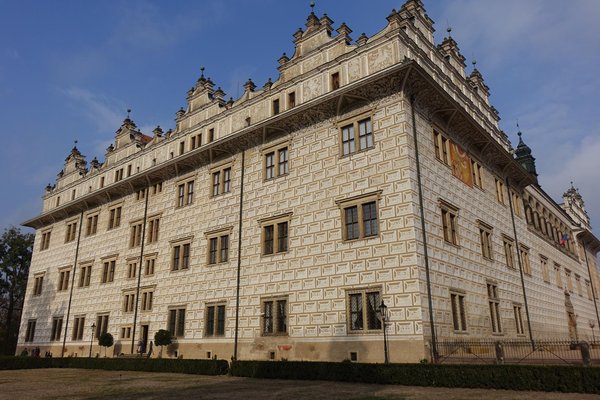Czechia
Litomysl Castle
Litomyšl Castle is a monumental Renaissance castle dating from the late 16th century.
This aristocratic country residence was built as an Italian-style arcade castle. Despite later reconstructions of interiors especially at the end of the 18th century, including the addition of a fine neoclassical theatre, the appearance of the castle remained almost intact including the unique sgraffito exterior decoration.
Community Perspective: The rectangular blocks of sgraffiti are the most outstanding part of the exterior. For the interior, try to get on a tour that takes you to the theater.
Site Info
Official Information
- Full Name
- Litomysl Castle (ID: 901)
- Country
- Czechia
- Status
-
Inscribed 1999
Site history
History of Litomysl Castle
- 1999: Inscribed
- Inscribed
- Type
- Cultural
- Criteria
- ii
- iv
Links
- UNESCO
- whc.unesco.org
- Official
-
- zamek-litomysl.cz — Litomysl Castle
- Related
-
- radio.cz — Litomysl: Bedrich Smetana s home town
All Links
UNESCO.org
- whc.unesco.org — whc.unesco.org/
Official Website
- zamek-litomysl.cz — Litomysl Castle
Related Resources
- radio.cz — Litomysl: Bedrich Smetana s home town
Community Information
- Community Category
- Secular structure: Palace
Travel Information
Recent Connections
-
Perfect Inscriptions
1999 -
Depicted in Mizielinska Maps
See i.pinimg.com
-
European Route of Historic Theatres
18th century Palace theatre - Emperor R…
Connections of Litomysl Castle
- Trivia
- Architecture
-
-
Rococo
reading room in the interior -
Baroque
sundials and 18th century modifications of the interior -
Neoclassical architecture
The theatre -
Renaissance
-
French (formal) garden
-
Sgraffito
-
English garden
Castle garden
-
- World Heritage Process
- Human Activity
-
-
Breweries
AB evaluation :- "Among the ancillary buildings, the most interesting is the Brewery, which lies to the south of the first courtyard. Originally constructed as a counterpart to the castle, with sgraffito decoration, it was substantially reconstructed after the 1728 fire and received what is its present appearance, which blends elements of High Baroque and Neo-Classicism, after the 1775 fire". "Bed?ich Smetana, one of the best Czech composers of all time, was born in the Litomy?l castle brewery in 1824" (His father had "managed several breweries before coming to Litomy?l in 1823 as brewer to Count Waldstein, whose Renaissance castle dominates the town" - Wiki). -
Festivals
Smetana opera Festival
-
- Constructions
-
-
Sundial
2 of them -
Horse Stables
-
Loggia
AV evaluation Of the features in the interior of the castle one of the most striking is the fine Neo-Classical theatre from 1796-97 in the western wing. Constructed entirely of wood, it can seat 150 spectators in nine loggias and its lower floor" -
Theatres and Opera Houses
Neo-Classical theatre from 1796-97 inside the castle
-
- WHS on Other Lists
-
-
European Route of Historic Theatres
18th century Palace theatre - Emperor RouteSee www.erht.eu
-
- Timeline
-
-
Built in the 16th century
completed in 1580, but with considerable modifications from 1719 onwards in the High Baroque style (AB ev)
-
- WHS Hotspots
- Science and Technology
-
-
Libraries
in the 17th century it held 4,000 books
-
News
No news.
Recent Visitors
Visitors of Litomysl Castle
- Adrian
- Adrian Turtschi
- Afshin Iranpour
- Alexander Barabanov
- Alexander Lehmann
- A. Mehmet Haksever
- Anna Wludarska
- Argo
- Artur Anuszewski
- Atila Ege
- BaziFettehenne
- Bin
- Bropyk
- Carlos Sotelo
- Christer Sundberg
- Christian Wagner
- Christoph
- Christravelblog
- Claire Bradshaw
- Clyde
- Corinne Vail
- Cristina Erba
- Csaba Nováczky
- Dagmara
- Daniela Hohmann
- Daniel Chazad
- Dan Pettigrew
- David Berlanda
- Dimitar Krastev
- Dolemite92
- Dorejd
- Els Slots
- Erik Jelinek
- Errol Neo
- Eva Kisgyorgy
- Fan Yibo
- Farinelli
- Felicité
- Femke Roos
- Filip Murlak
- Frederik Dawson
- FS
- Gary Arndt
- g.emma_bae
- George Gdanski
- GeorgeIng61
- Harald T.
- Harry Mitsidis
- Hubert
- Iain Jackson
- Ian Cade
- Ivan Rucek
- Jacob Choi
- Jakob F.
- Jana and Matt
- Janina Lehmann
- janis
- Janos
- Jan-Willem
- Jarek Pokrzywnicki
- Jay T
- Jens
- Jezza
- Joel on the Road
- Jonas Hagung
- Jonas Kremer
- Jonas Martinsson
- jonathanfr
- Jon Eshuijs
- Joyce van Soest
- KarenBMoore
- Kasia M.
- Klaus Freisinger
- Kurt Lauer
- Lara Adler
- lichia
- Little Lauren Travels
- ljowers
- Loic Pedras
- Luboang
- Ludvan
- Luis Filipe Gaspar
- Maciej Gil
- Maciej Gowin
- Małgosia Łupicka
- marcel staron
- Martin
- Martina Rúčková
- Marty
- Matejicek
- Matthewsharris
- Michael Novins
- Michael Turtle
- Mikko
- Mohboh
- Naim Y
- nan
- Nihal Ege
- Olli-Pekka Turunen
- Patrik
- Paul Schofield
- PeterH
- Peter Lööv
- Petteri
- Philipp Leu
- Philipp Peterer
- Piotr Wasil
- Purrfect
- Rafał Kałczuga
- Ralf Regele
- Randi Thomsen
- rivr
- Roger Ourset
- Roman Bruehwiler
- Roman Raab
- Sandmann15
- serghei.belous
- Sergio Arjona
- Shandos Cleaver
- Shijie ZHU
- Solivagant
- Stanislaw Warwas
- Stijn
- Svein Elias
- Szucs Tamas
- Tamara Ratz
- Taotao Chen
- Tarquinio_Superbo
- Tevity
- Thomas Buechler
- Thomas van der Walt
- Thorben
- Tim Allen
- tony0001
- triath
- Tsunami
- usagi1974
- Vanessa Buechler
- VB73
- WalGra
- Walter
- Wojciech Fedoruk
- YaroMir
- Yevhen Ivanovych
- Zhenjun Liu
- Zoë Sheng
Community Reviews
Show full reviews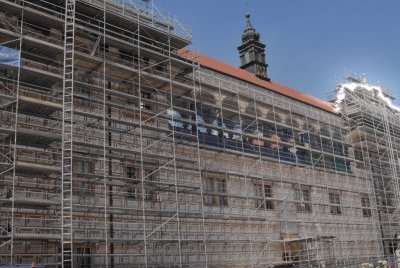
The Litomysl Castle is on my penultimate day of Czechia WHS circuit. I am not going to add much to the comments already posted except for my experience, or lack thereof during the visit.
1) the site is under renovation so the side of the castle is covered by scaffolding and screening. The Sgrafiti are therefore not visible from the entrance side. The other side with the lawn is enclosed by construction fencing, thus you can’t get a photo. I was lucky to sneak in for a few photos when the construction crew was changing shifts and opened the gate.
2) Inside the courtyard, they are building a music performance platform therefore obscuring the sgrafiti inside.
3) There was no English language guided tour or self guided tours for the interior rooms.
4) The room that was supposed to explain “Why Litomysl became a UNESCO WHS in English “ had only Czech language displays.
Keep reading 0 comments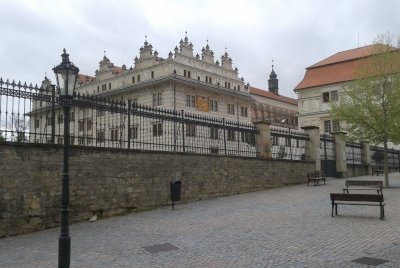
I still do not understand why this castle became WHS, but I am not expert on renaissance castles... Maybe I am slightly biased, but I perefer Italian originals. Well, the exterior is interesting (described already by other travellers), but during the guided tour I could not see anything exceptional inside the castle.
However, the town of Litomyšl is very pleasant and relaxed, and it is always refreshing after travelling from busy Prague. The cultural spirit of Litomyšl is expressed by testimony of the composer Friedrich (Bedřich) Smetana (annual music festival Smetanova Litomyšl) and also by exceptional artist Josef Váchal (1884-1969) - the unique museum of Váchal, so called Portmoneum, is very close to the castle.
Keep reading 0 comments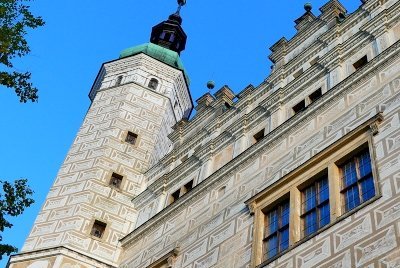
I visited this WHS in Summer 2019 and used Litomysl as my base for 1 night. This was ideal to enjoy the gorgeous sunset light on the castle but everything seems to close down after 7pm so having a decent dinner proved to be impossible.
The castle's highlight feature and the main reason for this WHS's inscription are the sgraffito designs. These were badly damaged (primarily due to countless fires) and were gradually covered with layers of plaster. As late as the 19th century, there was an increased interest and some of the sgraffito was uncovered in the 1930s, with only around 30 % of the authentic Renaissance sgraffito preserved. Further restoration was carried out in the 1950s. The current appearance of the castle is the result of a complex restoration intervention performed between 1973 and 1989. The sgraffito facades were entirely uncovered and the preserved sections were restored and filled in. The so-called cavetto cornices on the southwest and southeast facades were reconstructed. This feature which appears to be an intact component of the Renaissance building is in fact a steel construction filled with a reinforced concrete shell and decorated with compositions, and the same can be said about part of the remodelling of the castle to house the Museum of Czech Music. Even though the end result is aesthetically pleasing, it gave me the same lack-of-authenticity feeling I had when visiting parts of Samarkand, Uzbekistan, especially since this type of restoration is quite weak and really not …
Keep reading 0 comments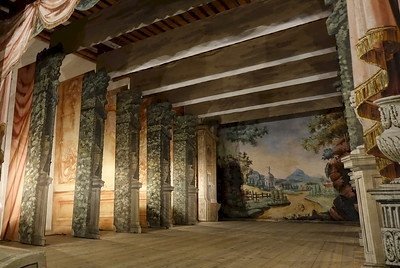
Litomysl Castle was one of the three castles of southeast Czechia that were still on my to-do list. I decided to tackle all of them (Litomysl, Kromeriz and Lednice/Valtice) during one fast-paced weekend break. Early Saturday morning I flew to Vienna, a more convenient hub than Prague for this scope. There I rented a car and drove for 3 hours until I arrived in Litomysl. Not all rental companies allow you to take the car from Austria into Czechia (Sixt does). And you have to be aware to buy a Czech toll vignette at a petrol station after crossing the border. Otherwise, it’s all straightforward.
Thanks to its ca. 8,000 sgraffito ‘bricks’ that fully cover its exterior, this Castle strongly stands out amidst its baroque surroundings. It is located above the town center on Castle Hill and surrounded by a French formal garden, the English style castle garden, the brewery, riding hall, stables and carriage house – which all belong to the core zone too.
I did not plan to take castle tours at all 3 castles this weekend, but for Litomysl I thought it could be worth it because its tour includes a visit to the 18th-century theatre. Between April and October, there are regular tours scheduled. At the ticket office, I was put on the list for the 2 pm tour. So I had over an hour to spare, which I spent in the city center (‘dead’ on a Saturday afternoon, just as I experienced in …
Keep reading 0 comments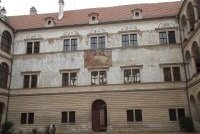
I found the chateau at Litomysl somewhat underwhelming, and could not identify any features of outstanding universal value.
The train from Chocen to Litomysl no longer operates. The best connection to the site I could find was by bus from Ceska Tribova station.
Keep reading 0 comments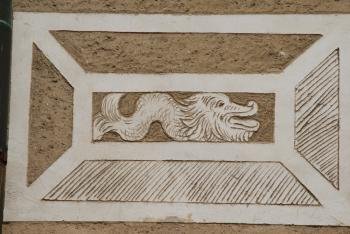
The special feature of the Renaissance castle in Litomysl is the faҫade, the complete outside is decorated with thousands of rectangular sgraffiti. The images are different from each other - fruits, animals, people, leaves - and we had great fun identifying our favourites (the photo shows one of mine). The faҫade is largely uniform and only the south wing is interrupted by arcades at the top floor. The courtyard has three-storey arcades at three sides and on the northern wall are large sgraffiti depicting ancient and biblical scenes.
At the time of our visit the area between the castle and the outbuildings was inaccessible due to construction works (also the nearby cathedral). But as we stood at the fence and tried to view the sgraffiti decorations, a construction engineer became aware of us. We told him that we came 500 km from Austria to visit the castle. Then he allowed us to go in and we could view the castle from all sides.
Sure, Litomysl is just one among many castles on the WH list, but I liked its unusual exterior: the sgraffiti, the Renaissance gables and the arcades in the courtyard.
Keep reading 0 comments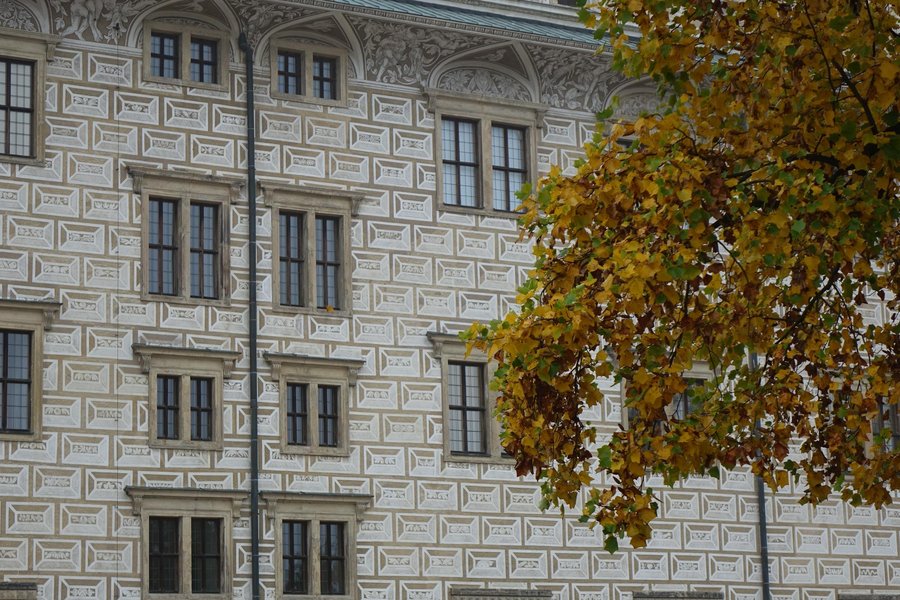
Well, this is another typically Central European palace, nice, but nothing extraordinary. It takes a while to get to this town by public transport, and once you have reached the palace, you can go on a guided tour - of course only in Czech - and see the usual procession of rooms. They are reasonably nice and interesting, and Litomysl is a pleasant enough town, but this is really something for World Heritage collectors. The theater is probably the most interesting part.
Keep reading 0 comments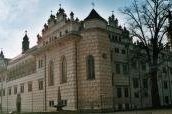
I have been many times to the huge castle of Litomyšl, a Renaissance masterpiece, projected by Giovanni Battista and Ulrico Aostalli, that belonged to the family Pernštejn. It is an asymmetrical building with four wings and three storeys: one of them is largest and another one has a two-storeyed arcaded groin-vaulted gallery, that continues in the second court on other two sides; there is also a polygonal tower and a smaller oblong court. The external facades, that have graffiti imitating diamond ashlars and a lunette on everyone, have also above the plinth of the ground floor and on the other floors stone biforate windows with reveals, lintels, hood mouldings and volute brackets; the main portal on the south façade has a semicircular arch, two double rusticated columns and a flat lintel with the coats of arms of the Pernštejn and Manriques de Lara families. Above the cornice is an attic gable with pilasters and windows and the finials have squat bases, pillars and a small attachment. On a façade there is the end of the chapel, with twin triforate lancet windows and a polygonal turret with a pyramidal roof. The second courtyard has on three sides semicircular arcades; on the ground floor are rusticated pillars,arches and spandrels and the other floors have columns with feet, block socles, plinths and Tuscan capitals on the first floor, Ionic on the second; between the plinths are parapet walls with central pilaster strips. One façade has between the window sill of the first floor …
Keep reading 0 comments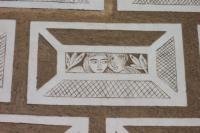
This was one of my favourite trips in the Czech Republic. The interior of the palace is nothing remarkable; however the exterior and the town itself were very rewarding.
The main feature of the castle is the sgraffiti decoration on the outside, what from a distance look like bricks are in fact designs made from etching away plaster to reveal the undercoat. Each design is different; the centres contain many different images, from leaves to people. It gives a very nice impression, it also features on the main wall of the interior colonnaded courtyard but it is used here to depict biblical/ mythical scenes on a much larger scale.
The only way to see the interior of the castle is on a tour of which there are two different types. If you do want to see the interior I would recommend trying to get the tour which includes the theatre as I hear this is the highlight. Unfortunately I ended up on the second tour which led me on a procession through yet another average European Castle. I wish I hadn’t wasted my time on it.
The Castle is situated just above the centre of the town and was the birthplace of the composer Bedrich Smetana. He plays a large role in Czech cultural heritage and many concerts are given in his honour through out the year.
The interior of the castle did hold one more delight though, in the shape of the former wine vaults. These now house a …
Keep reading 0 comments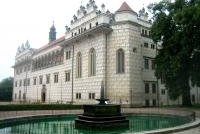
The name Litomyšl goes back to the year 981 when a hill fort was first mentioned in a Bohemian Chronicle. Today’s Litomyšl is a friendly little Czech town just waiting to be explored by tourists and with a brilliant Renaissance arcade-castle.
Vratislav of Pernštejn was the nobleman who took over the castle in 1567 and started its transformation into a large-scale palace with courtyards and porticoes covered with “s-graffiti”, a technique of wall decoration, where layers of plaster in contrasting colours is applied on to a moistened surface, and then scratched to produce a drawing. The interior of the Litomyšl Castle offers well-kept rooms and richly decorated salons and can also boast one of Europe’s three surviving 18th century castle theatres.
Below the castle hill lies the small town with the same name, a beautiful little town with one of the largest squares in the Czech Republic flanked by Renaissance and Baroque houses and arcades to keep you out of the rain or burning sun.
Keep reading 0 comments
